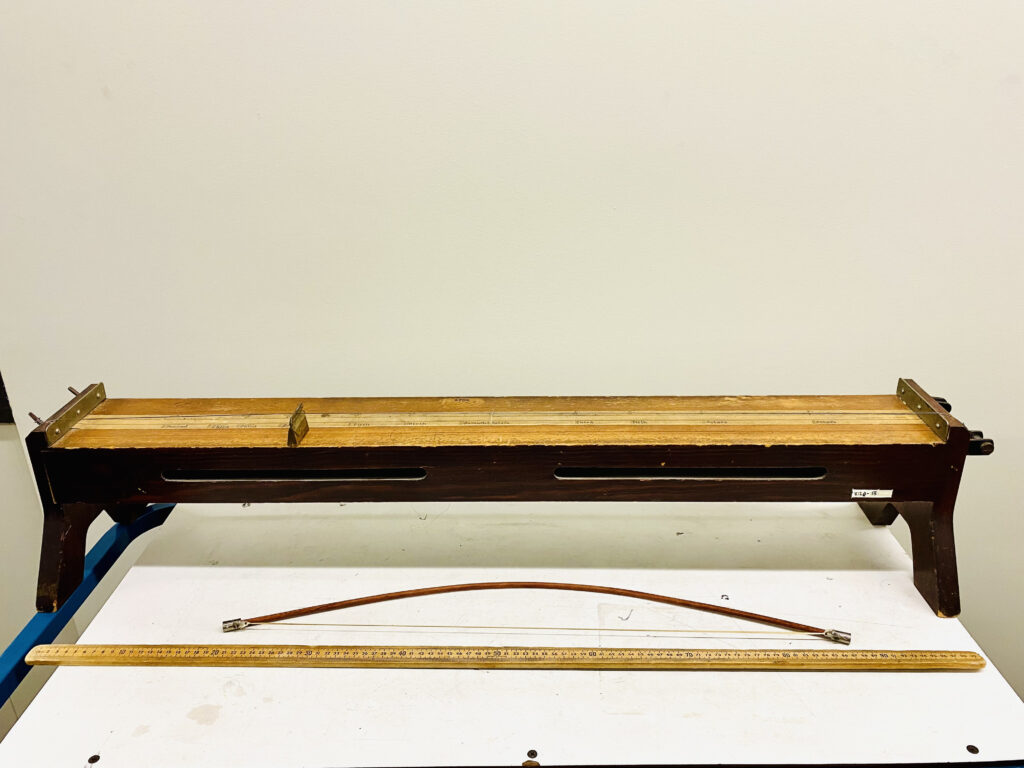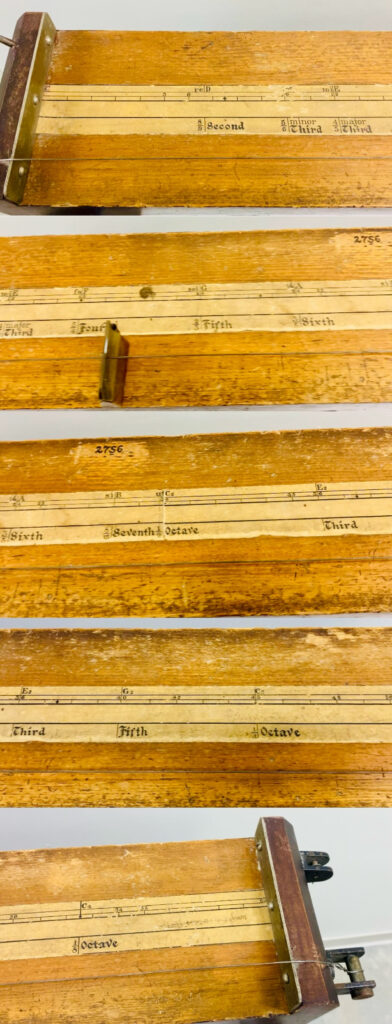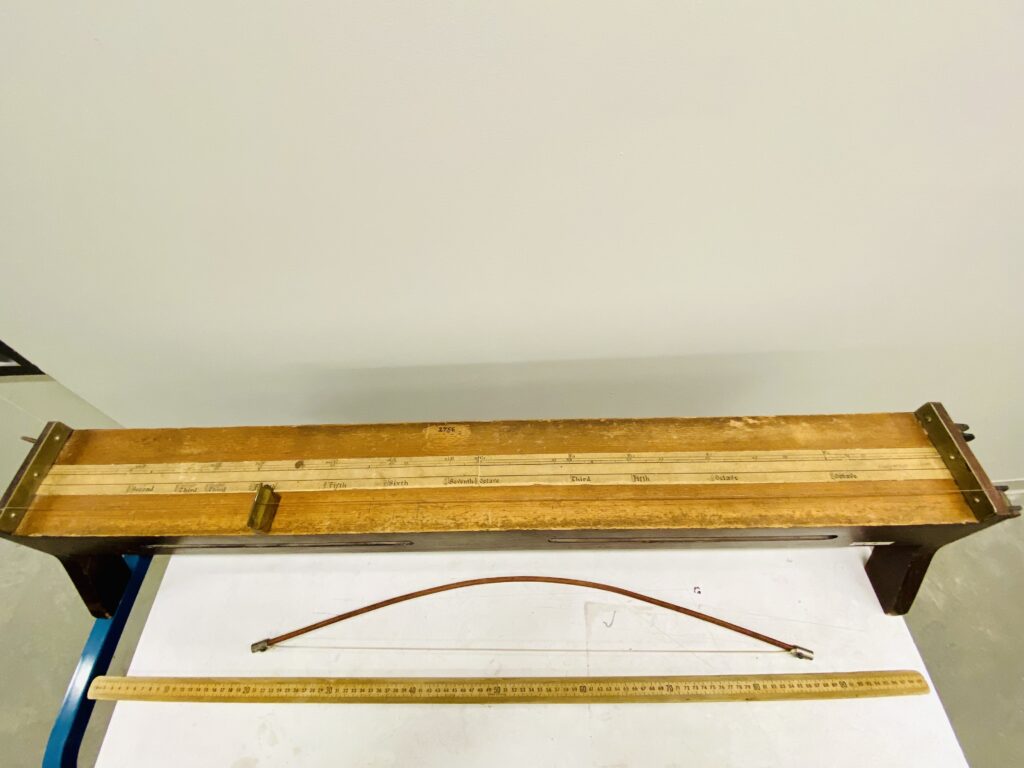Artefacts
Sonometer
Sonometer
Written in marker on the front of the wooden box in the lower right corner is V12A-13.
In the upper center of the wooden box is written in marker 27S6.
The panel is marked with a scale. From left to right they are: re|D, damaged beyond recognition, mi|E, fa| F, sol|G, la|A, si|B, ut| C2, E2, G2, C3, C4.
The following rows correspond to each of them: 8/9|Second, 5/6|minor Third, 4/5|major Third, 5/4|Fourth, 2/3|Fifth, 3/5|Fourth, 2/3|Fifth, 3/5|Fifth, 3/4|Fourth, 3/4|Fifth, 3/4|Fifth, 3/4|Fourth, 3/4|Fourth, 3/4|Fourth, 3/4|Fifth, 3/4|Fourth, 3/4|Fourth, 3/4|Fifth, 3/4|Fourth, 3/4|Fourth, 3/4|Fourth, 3/5|Fourth, 4/5|Fourth.
Description
The Sonometer is a musical and scientific instrument with ancient roots, commonly employed in demonstrations of acoustics to show the effect of length, tension, diameter, and materials on the pitch of a vibrating string. One may also show the harmonics of a vibrating string.
This sonometer is a long hollow wooden box along the top of which are stretched one or more strings of exactly the same length rigidly attached to the box at one end, with provision at the other for changing their tension. The length of the string can be adjusted by moving the bridge under it. A violin bow is also available if you wish to play a continuous tone rather than plucking the string.
If there is just one string, it’s known as a monochord, first mentioned in Greece in the 5th century BCE, and said to have been invented by Pythagoras. The monochord was modified by the French instrument maker, Albert Marloye, in the mid 1800’s and became known as a differential sonometer. In its earliest form, the string was stretched across two fixed bridges which were erected on a plank or table. A movable bridge was then placed underneath the string, dividing it into two sections. The marks indicating the position of the fixed bridge were inscribed on the table beneath the string. The resonating box, seen in drawings after the 12th century, was a late medieval addition which increased the portability in addition to enhancing the tone of the monochord. Both monochord and sonometer are available for demonstrations. Several experiments are possible.
1) In order to show that the frequency varies inversely as the length of the vibrating string, the length of each string can be changed by moving a bridge under it. If the string is plucked near one end and stopped at 1/2, 1/3, 1/4, 1/5, etc, of its length, the 2nd, 3rd, 4th, 5th, etc. harmonics will be sounded. If a sharp-edged piece of soft rubber (an eraser) is used to stop the string, it is possible to make 10 or more harmonics audible.
2) In order to demonstrate intervals, one can make the string 2/3 of its original length, and the pitch rises exactly a perfect fifth, a fraction 3/2 above its original frequency. If one makes the length 3/4 long, the pitch rises a perfect fourth, or a fraction 4/3 above what it was.
3) The frequency varies directly as the square root of the tension. The string passes over a pulley, and the tension is thus provided by hanging a weight from the end of the string – by quadrupling the weight, one obtains results twice the frequency.
4) Finally, the frequency varies inversely as the square root of the mass per unit length of the string.
Operation
Using the tuning key, tune the string to 256 Hz (middle C or in scientific usage C4). Fold the small piece of paper to be used as a ‘rider’ to determine nodes.
Pluck the string. Using the ‘rider’ determine the position of the nodes at the vibrators. Using a finger to stop the string at the ‘nodes’ of harmonics; select various harmonies from the string. Using the metal bridge, demonstrate the relationship of the lengths needed to produce various notes with relation to the fundamental. And for a closing ‘note’, pluck the string and turn down the tension; the frequency drops.
Dimensions: Length: 107cm; Width: 13 cm; Height: 19cm;
Condition: Fair condition
© 2015 – 2024 Humboldt-Universität zu Berlin













